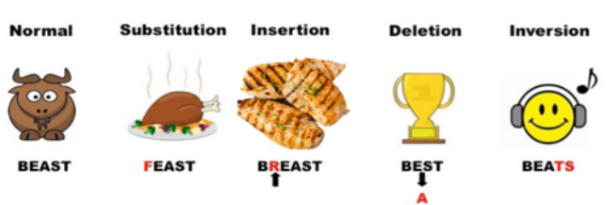Heredity (Module 5)
5.0(1)
5.0(1)
Card Sorting
1/125
Earn XP
Description and Tags
Study Analytics
Name | Mastery | Learn | Test | Matching | Spaced |
|---|
No study sessions yet.
126 Terms
1
New cards
What is asexual reproduction?
reproduction that involves only one parent and no gametes, resulting in offspring that are **genetically identical** to both each other and the parent.
2
New cards
What are the disadvantages of asexual reproduction?
no genetic diversity (change in environment can wipe out a species, inability to adapt, no variation (genetic diseases are carried down)
3
New cards
What are the advantages of asexual reproduction?
less time consuming, less energy, population can rapidly increase, well suited to environment
4
New cards
What is sexual reproduction?
the fusion of two different gametes that combine to create a **genetically new individual**
5
New cards
What are the disadvantages of sexual reproduction?
time-consuming, more energy, change (not suited to environment)
6
New cards
What are the advantages of sexual reproduction?
genetic diversity, allows for evolution and adaptation, change in environment/selection pressures will not wipe out species
7
New cards
How do animals reproduce?
sexually through the union of male and female gametes (sperm and ova).
8
New cards
What are gametes and how are they produced?
gametes are reproductive cells produced by parent organisms through meiosis. Each gamete contains half the necessary number of chromosomes.
9
New cards
What is the role of the male and female gametes in reproduction?
the male gamete (sperm) fertilises the female gamete (ovum) to initiate reproduction.
10
New cards
What is the result of the fusion of gametes?
production of a **zygote**, (contains combination of genetic material from both parental organisms)
11
New cards
What is internal fertilisation?
sperm fertilises the egg **within** the female's body. E.g. Reptiles, birds, and mammals.
12
New cards
What are some characteristics of internal fertilisation?
* union occurs predominantly on land - into the female’s reproductive tract via penis or copulation
* large number of male gametes, fewer female gametes
* high chance of fertilisation
* increased chance of survival - protected
* takes longer for offspring to develop
* fewer offspring produced
* zygote develops in protected environment - inside the females body
* large number of male gametes, fewer female gametes
* high chance of fertilisation
* increased chance of survival - protected
* takes longer for offspring to develop
* fewer offspring produced
* zygote develops in protected environment - inside the females body
13
New cards
What is external fertilisation?
involves the fusion of gametes (egg and sperm) outside of the parent's body. E.g. amphibians and fish.
14
New cards
what are some characteristics of external fertilisation?
* union occurs in open water environments
* conception - simultaneous release of gametes
* large number of male and female gametes produced
* lower chance of fertilisation
* lower chance of survival - exposed
* takes less time for offspring to develop
* more offspring produced
* zygote develops externally (watery environment), vulnerable to environmental elements
* conception - simultaneous release of gametes
* large number of male and female gametes produced
* lower chance of fertilisation
* lower chance of survival - exposed
* takes less time for offspring to develop
* more offspring produced
* zygote develops externally (watery environment), vulnerable to environmental elements
15
New cards
What are the types of sexual reproduction in mammals?
placental, marsupial and monotreme
16
New cards
How do placentals reproduce?
* bear live young, nourished/protected before birth in mother’s uterus.
* after birth baby is nourished milk and develops a covering of fur
* seen in humans, horses, dogs, etc.
* after birth baby is nourished milk and develops a covering of fur
* seen in humans, horses, dogs, etc.
17
New cards
How do marsupials reproduce?
\
* underdevelopment of joey protected and nourished in pouch after early birth
* remain in pouch until development is complete
* seen in kangaroos, wombats, etc.
* underdevelopment of joey protected and nourished in pouch after early birth
* remain in pouch until development is complete
* seen in kangaroos, wombats, etc.
18
New cards
How do monotremes reproduce?
* lays eggs
* hatched to be protected and fed by mother
* seen in platypus, echidna, etc>
* hatched to be protected and fed by mother
* seen in platypus, echidna, etc>
19
New cards
What parts of a flower are involved in sexual reproduction?
* pistil
* stigma
* style
* ovary
* stamen
* anther
* filament
* petal
* ovule
* stigma
* style
* ovary
* stamen
* anther
* filament
* petal
* ovule
20
New cards
What is are the female parts of of a flower?
* pistil - female part of flower, consisting of stigma, style and ovary
* stigma - top of female part, sticky to collect pollen
* style - tubular structure, pollen creates a tube to get to ovary
* ovary - protect female sex cells (ovules)
* stigma - top of female part, sticky to collect pollen
* style - tubular structure, pollen creates a tube to get to ovary
* ovary - protect female sex cells (ovules)
21
New cards
What are the male parts of a flower?
* stamen - male part of flower, consists of anther and filament
* anther - produce male sex cells (pollen grains)
* filament - holds up anther
* anther - produce male sex cells (pollen grains)
* filament - holds up anther
22
New cards
What are the three steps of sexual reproduction in plants?
* pollination
* pollination and fertilisation
* seed dispersal
* pollination and fertilisation
* seed dispersal
23
New cards
What is pollination?
the process of transferring pollen from the anther of a flower to the stigma of another flower
* pollinators (bees) transfer pollen from one flower to another
* pollinators (bees) transfer pollen from one flower to another
24
New cards
What is fertilisation (in plant reproduction)?
occurs after pollination
* pollen on stigma sends a pollen tube down the style to ovary
* pollen tube enters ovule through hole in micropyle
* nuclei fuses with ovum to form zygote
* pollen on stigma sends a pollen tube down the style to ovary
* pollen tube enters ovule through hole in micropyle
* nuclei fuses with ovum to form zygote
25
New cards
what is seed dispersal
following successful pollination and fertilisation of flower, seed develops
* seeds dispersed by wind or animals (insects, birds, mammals)
* advantage - spread over wide distance to prevent overcrowding, which increases chances of survival if environmental change occurs
* seeds dispersed by wind or animals (insects, birds, mammals)
* advantage - spread over wide distance to prevent overcrowding, which increases chances of survival if environmental change occurs
26
New cards
What is an advantage of sexual reproduction in plants?
creates genetic diversity
* greater ability to adapt to changing conditions
* greater ability to adapt to changing conditions
27
New cards
What is a disadvantage of sexual reproduction in plants?
can prevent favourable genes from being passed on to offspring
28
New cards
What are the types of asexual reproduction in plants?
* vegetative propagation
* binary fission
* budding
* spores
* fragmentation
* binary fission
* budding
* spores
* fragmentation
29
New cards
What is vegetative propagation?
new individuals develop from fragments of adult’s roots, stems, leaves or buds
* runners: strawberries (new roots grow from runner to make a new plant)
* tubers: potatoes (new plants grow from tuber)
* grafts: commercially used to produce desirable traits in flowers
* runners: strawberries (new roots grow from runner to make a new plant)
* tubers: potatoes (new plants grow from tuber)
* grafts: commercially used to produce desirable traits in flowers
30
New cards
What are the advantages of vegetative propagation?
* clones of parent - traits passed on can be advantageous for farmers
* less energy intensive - population can increase rapidly
* less energy intensive - population can increase rapidly
31
New cards
What are the disadvantages of vegetative propagation?
* limited genetic diversity
* pathogens can spread easily from parent to offspring
* pathogens can spread easily from parent to offspring
32
New cards
What is binary fission and what is its process?
single celled parents organism undergoes mitosis to produce two new organisms (e.g. bacteria, protists)
1. bacteria/protist must replicate it’s genetic material
2. cytokinesis occurs, dividing the organism into two parts
3. each new organism receives one copy of DNA
1. bacteria/protist must replicate it’s genetic material
2. cytokinesis occurs, dividing the organism into two parts
3. each new organism receives one copy of DNA
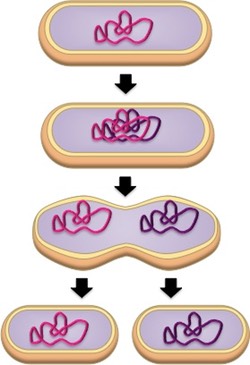
33
New cards
What is budding?
new organism is formed from an outgrowth from the original parent
* when outgrowth is large enough it frees itself from parent
* e.g fungi and protists
* when outgrowth is large enough it frees itself from parent
* e.g fungi and protists
34
New cards
What are spores?
single cells produced by an organism and released into environment to reproduce
* spores are produced by one parent via mitosis and will germinate if conditions are right
* spores are produced by one parent via mitosis and will germinate if conditions are right
35
New cards
What is fragmentation?
occurs when organism breaks into two or more pieces - whole new organism is produced from each piece
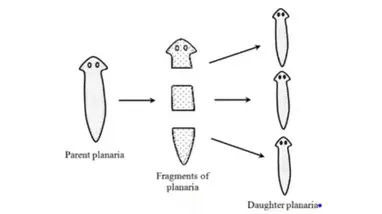
36
New cards
Menstrual cycle
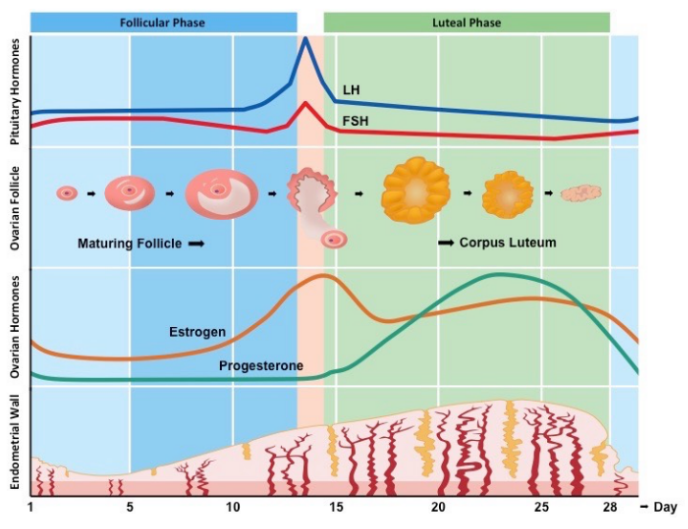
37
New cards
What are the two phases of the menstrual cycle?
follicular and luteal
38
New cards
What is a hormone?
regulatory substance produced in an organism and transported in tissue fluids such as blood or sap to stimulate specific cells or tissues into action.
39
New cards
What happens during the follicular phase of the menstrual cycle?
* low levels of oestrogen and progesterone stimulate production of FSH (Follicle Stimulating Hormone) from the pituitary gland
* dominant follicle (contains egg) produces oestrogen, which inhibits FSH secretion through negative feedback
* Oestrogen acts on the uterus to stimulate the thickening of the endometrial layer (preparing for pregnancy) - stimulates the maturation of ovarian follicles (contain egg)
* egg matures in ovaries
* dominant follicle (contains egg) produces oestrogen, which inhibits FSH secretion through negative feedback
* Oestrogen acts on the uterus to stimulate the thickening of the endometrial layer (preparing for pregnancy) - stimulates the maturation of ovarian follicles (contain egg)
* egg matures in ovaries
40
New cards
What occurs during ovulation?
process where dominant follicle ruptures and releases an egg
* oestrogen stimulates the **anterior pituitary** to secrete hormones
* results in a large surge of luteinising hormone (LH) and a lesser surge of FSH from the pituitary gland
* LH causes rupture of dominant follicle leading to ovulation
* oestrogen stimulates the **anterior pituitary** to secrete hormones
* results in a large surge of luteinising hormone (LH) and a lesser surge of FSH from the pituitary gland
* LH causes rupture of dominant follicle leading to ovulation
41
New cards
What happens during the luteal phase of the menstrual cycle?
* ruptured follicle develops into slowly degenerating structure called corpus luteum
* corpus luteum secretes high levels of progesterone, lower levels of oestrogen
* hormones act on uterus to thicken endometrial lining further - prepare for pregnancy
* hormones prohibit secretion of FSH and LH preventing other follicles from developing
* corpus luteum secretes high levels of progesterone, lower levels of oestrogen
* hormones act on uterus to thicken endometrial lining further - prepare for pregnancy
* hormones prohibit secretion of FSH and LH preventing other follicles from developing
42
New cards
What happens if fertilization occurs during menstruation?
developing embryo will implant in the endometrium and release hormones to sustain the corpus luteum.
43
New cards
What happens if fertilization doesn't occur during menstruation?
corpus luteum degenerates.
44
New cards
What happens to the levels of oestrogen and progesterone if fertilization doesn't occur during menstruation?
levels of estrogen and progesterone drop
45
New cards
What happens to the endometrium lining during menstruation?
The endometrium lining can no longer be maintained and is sloughed away as menstrual blood.
46
New cards
What is fertilisation?
action or process of fertilising an egg or a female animal or plant, involving the fusion of male and female gametes to form a zygote.
47
New cards
What is a haploid cell?
contains a single set of chromosomes.
48
New cards
What is a diploid cell?
cell with paired chromosomes from each parent.
49
New cards
What happens to the egg after fertilisation?
egg divides as it travels along the oviduct and begins developing into an embryo.
50
New cards
What happens to hormone production when the egg is fertilized and implants in the uterus?
When the egg is fertilized and implants in the uterus, the production of progesterone or estrogen remains high from the corpus luteum.
51
New cards
What is the journey of an ovule during ovulation?
the ovule travels down the fallopian tube with the help of tiny hairs attached to the walls of the oviduct.
52
New cards
What happens during the journey of sperm?
* Hundreds of thousands of sperm die when traveling through the fallopian tube
* thousands of them die instantly upon release due to the acidic environment
* one sperm penetrates the ovum's protective layer to fertilize the egg.
* thousands of them die instantly upon release due to the acidic environment
* one sperm penetrates the ovum's protective layer to fertilize the egg.
53
New cards
What happens during cell division and implantation?
fertilized egg soaks into the fresh blood on the walls of the uterus and stays attached until birth, providing time for the developing embryo to prepare for the growth of a baby.
54
New cards
What hormones are involved in hormonal control during pregnancy?
* progesterone (produced by the placenta and corpus luteum)
* maintains uterine wall
* suppresses uterine activity → supporting foetal development, reduces the risk of baby being disturbed by uterine contractions
* oestrogen (produced by the placenta and fetal liver)
* maintains uterine wall
* suppresses uterine contractions in late pregnancy
* HCG (produced by the developing embryo), and insulin (promotes fetal growth)
* maintains corpus luteum (in turn helps to maintain the endometrium)
* thickens uterine lining to support growing embryo
* maintains uterine wall
* suppresses uterine activity → supporting foetal development, reduces the risk of baby being disturbed by uterine contractions
* oestrogen (produced by the placenta and fetal liver)
* maintains uterine wall
* suppresses uterine contractions in late pregnancy
* HCG (produced by the developing embryo), and insulin (promotes fetal growth)
* maintains corpus luteum (in turn helps to maintain the endometrium)
* thickens uterine lining to support growing embryo
55
New cards
What are the requirements for birth to occur?
the muscles in the uterus must contract to expel the baby, and the tissue of the cervix must soften to allow its dilation.
56
New cards
How do hormones control the birthing process?
* progesterone and estrogen levels decline during labor, leading to stronger contractions.
* %%oxytocin%% stimulates uterine muscles to increase the strength and frequency of contractions.
* %%prostaglandins%% stimulates contractions
* %%relaxin%% helps to dilate cervix
* %%adrenaline%% if too stressed, can slow down contractions
* %%oxytocin%% stimulates uterine muscles to increase the strength and frequency of contractions.
* %%prostaglandins%% stimulates contractions
* %%relaxin%% helps to dilate cervix
* %%adrenaline%% if too stressed, can slow down contractions
57
New cards
What hormone stimulates milk production in the breasts during breastfeeding?
* prolactin, which is produced mainly in the pituitary gland, stimulates milk production.
* oxytocin release is also stimulated by suckling.
* oxytocin release is also stimulated by suckling.
58
New cards
What is selective breeding?
process of choosing parents with specific characteristics to breed together and produce offspring with more desirable traits.
59
New cards
What is artificial insemination?
fusion of sperm and ova without the normal mating process. It involves collecting sperm from a chosen male and artificially introducing it into selected females.
60
New cards
What is artificial pollination?
* pollination carried out by humans.
* involves manually transferring pollen from the stamen of one plant to the stigma of another plant.
* involves manually transferring pollen from the stamen of one plant to the stigma of another plant.
61
New cards
What is cloning?
process of generating a genetically identical copy of a cell or an organism.
62
New cards
What is DNA replication?
process of creating an exact copy of DNA, ensuring accurate transmission of genetic information during cell division.
63
New cards
What is mitosis?
the nuclear division of eukaryotic cells that allows for asexual reproduction, growth, and repair in multicellular organisms.
* interphase: DNA replication occurs to produce two copies of each chromosome
* prophase: duplicated chromosomes condense and spindle fibres form. nuclear membrane begins to break down
* metaphase: chromosomes line up across centre of the cell, attach to spindle fibres
* anaphase: sister chromotids are pulled apart by spindle fibres
* telophase: daughter chromosomes gather at opposite poles of cell, spindle breaks down, nuclear membranes assemble around two nuclei.
* cytokinesis: happens simultaneous to anaphase and telophase. daughter nuclei separate to become own cells
* interphase: DNA replication occurs to produce two copies of each chromosome
* prophase: duplicated chromosomes condense and spindle fibres form. nuclear membrane begins to break down
* metaphase: chromosomes line up across centre of the cell, attach to spindle fibres
* anaphase: sister chromotids are pulled apart by spindle fibres
* telophase: daughter chromosomes gather at opposite poles of cell, spindle breaks down, nuclear membranes assemble around two nuclei.
* cytokinesis: happens simultaneous to anaphase and telophase. daughter nuclei separate to become own cells
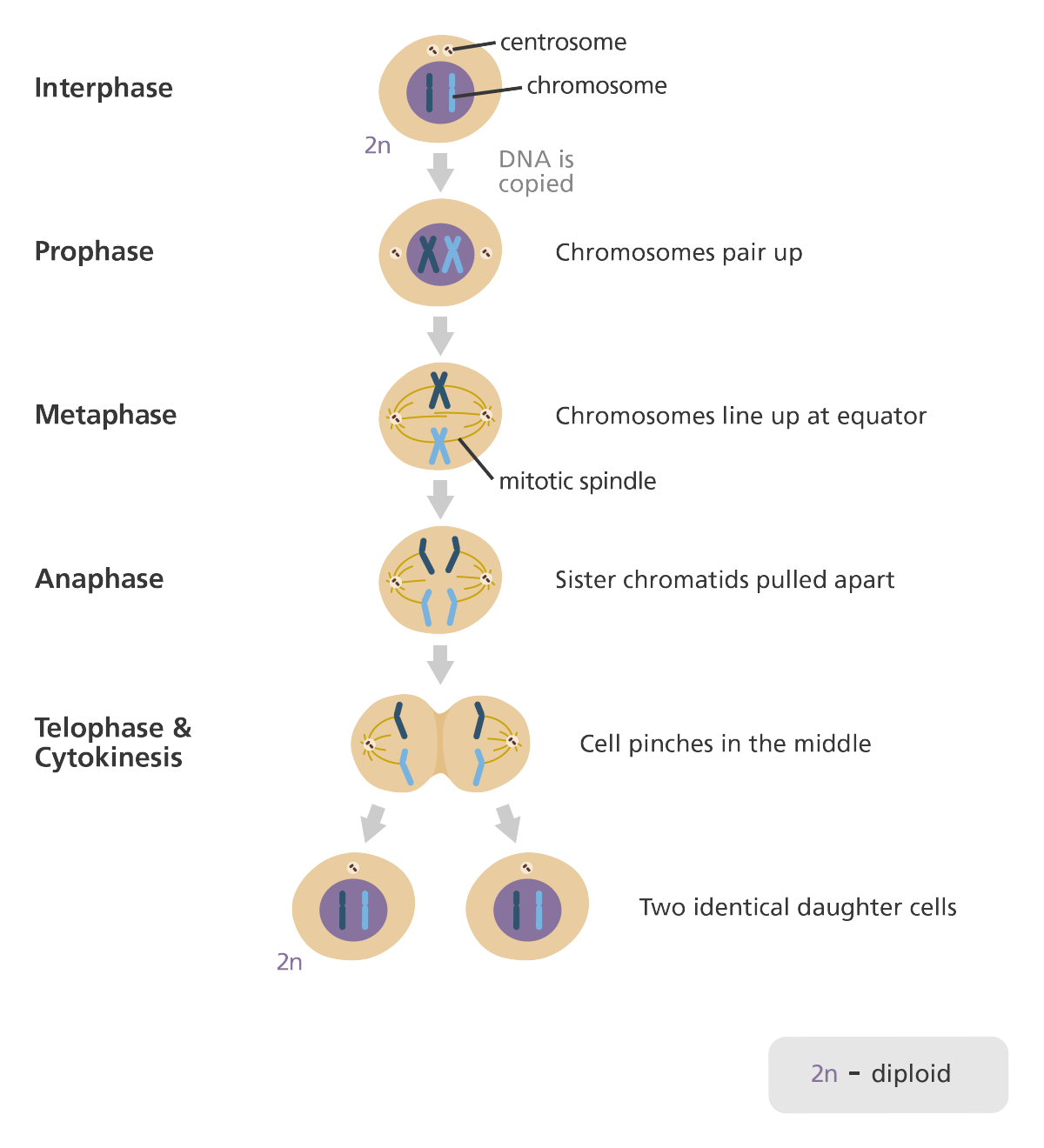
64
New cards
What is a chromosome?
DNA molecule that consists of part or all of the genetic material of an organism
* organisms have set number of chromosomes - humans= 46
* organisms have set number of chromosomes - humans= 46
65
New cards
What is a chromotid?
half of a chromosome
66
New cards
What is meiosis?
* cell division process that produces four daughter cells (gametes) with half the number of chromosomes of the parent cell.
* creates genetic diversity and is used in sexual reproduction.
* creates genetic diversity and is used in sexual reproduction.
67
New cards
Meiosis 1
produces TWO haploid cells → HOMOLOGOUS CHROMOSOMES are separated.
* interphase: DNA replication occurs to produce two copies of each chromosome
* prophase: chromosomes condense and nuclear envelope breaks down, homologous pairs line up, crossing over occurs between homologous chromosomes
* metaphase: homologous pairs (not the individual) line up along the equator of the separating cell
* anaphase: homologous pairs are separated, pulled apart. sister chromatids remain attached
* telophase: two diploid daughter cells are formed by cytokinesis
* interphase: DNA replication occurs to produce two copies of each chromosome
* prophase: chromosomes condense and nuclear envelope breaks down, homologous pairs line up, crossing over occurs between homologous chromosomes
* metaphase: homologous pairs (not the individual) line up along the equator of the separating cell
* anaphase: homologous pairs are separated, pulled apart. sister chromatids remain attached
* telophase: two diploid daughter cells are formed by cytokinesis
68
New cards
Meiosis 2
produces FOUR haploid cells → SISTER CHROMATIDS are separated
* prophase: chromosomes condense and the nuclear envelope breaks down
* metaphase: chromosomes line up along equator of dividing cells
* anaphase: sister chromatids separated by spindle microtubules and are pulled towards opposite poles of the cell
* telophase: cytokinesis occurs, four granddaughter cells are formed - each containing half the number of chromosomes of the parent cell
* prophase: chromosomes condense and the nuclear envelope breaks down
* metaphase: chromosomes line up along equator of dividing cells
* anaphase: sister chromatids separated by spindle microtubules and are pulled towards opposite poles of the cell
* telophase: cytokinesis occurs, four granddaughter cells are formed - each containing half the number of chromosomes of the parent cell
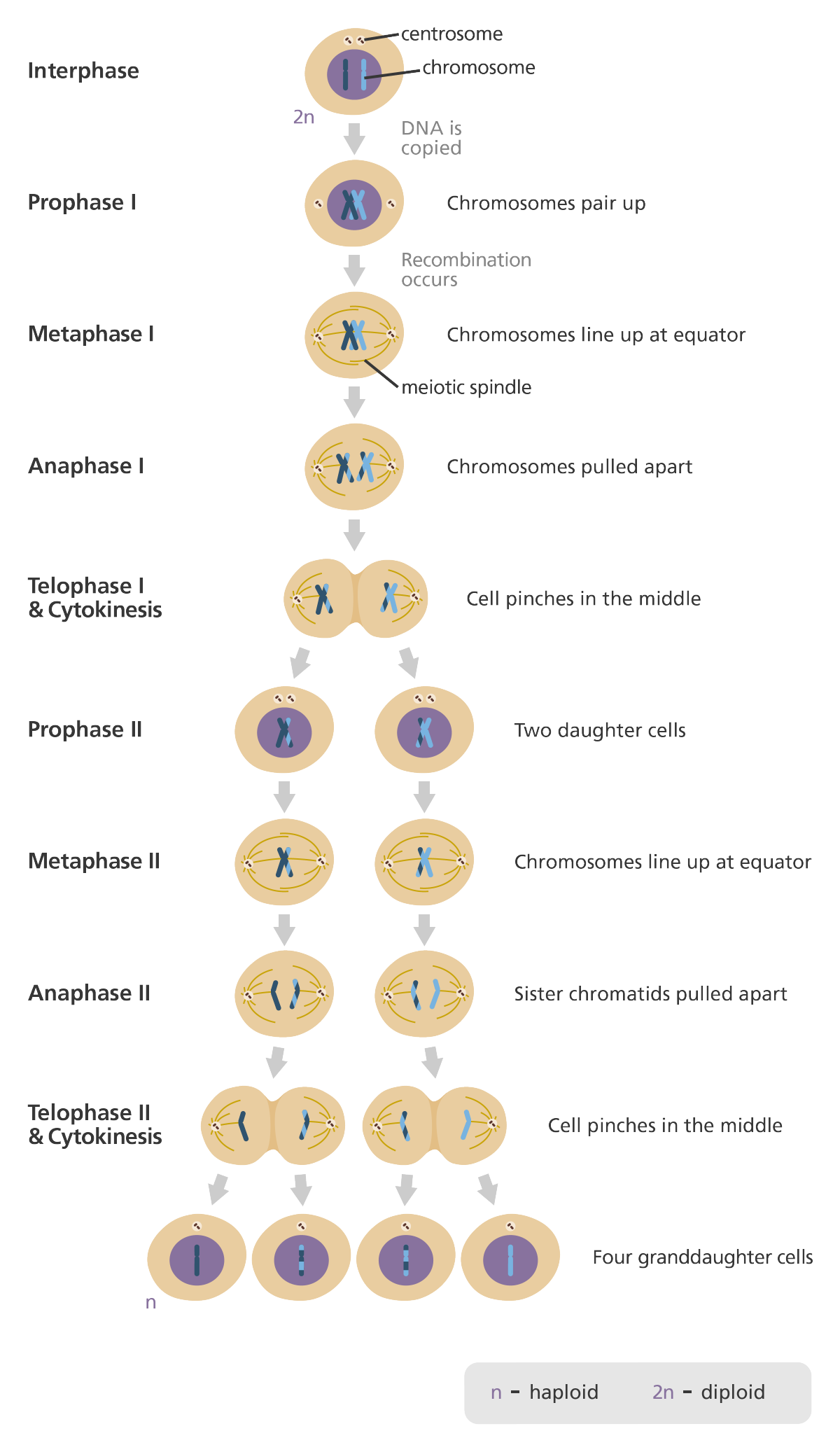
69
New cards
What is the Watson and Crick model of DNA?
consists of two strands of nucleotides that twist around each other in a double helix shape
nucleotides consists of three parts:
* sugar molecule
* phosphate molecule
* nitrogenous base (Adenine and Thymine, Cytosine and Guanine)
strands of DNA are held together by hydrogen bonds between the nitrogenous bases
nucleotides consists of three parts:
* sugar molecule
* phosphate molecule
* nitrogenous base (Adenine and Thymine, Cytosine and Guanine)
strands of DNA are held together by hydrogen bonds between the nitrogenous bases
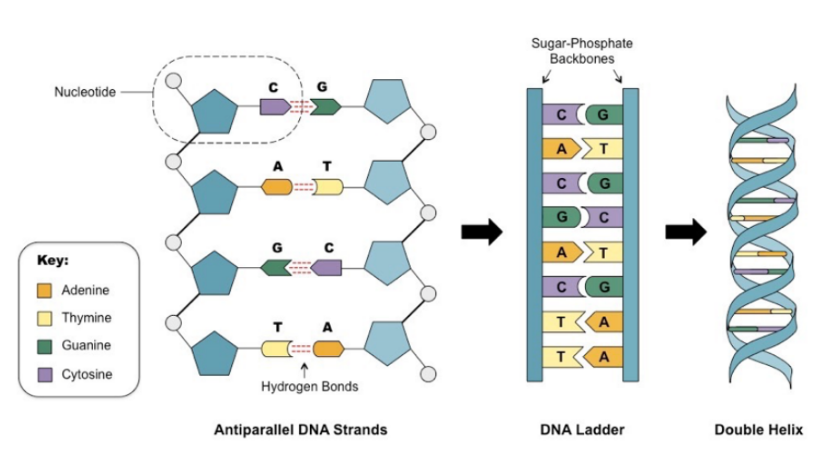
70
New cards
What is the process of DNA replication?
* **unwinding:** enzyme (helicase) breaks down hydrogen bonds between bases, allowing DNA molecule to ‘unwind’
* **splitting:** strand splits apart, two strands separate (exposing nucleotide bases)
* **priming the cell:** RNA primers attach to the exposed DNA strand to signal the starting point for replication
* **matching:** DNA Polymerase bring and binds complementary base to exposed strand
* **joining:** ligase sticks strands together, now there is double-stranded DNA, nucleotides are joined together along the sugar-phosphate backbone
* **two identical strands now exist!!** each DNA molecule contains one strand of existing DNA molecule and new synthesised strand.
* **splitting:** strand splits apart, two strands separate (exposing nucleotide bases)
* **priming the cell:** RNA primers attach to the exposed DNA strand to signal the starting point for replication
* **matching:** DNA Polymerase bring and binds complementary base to exposed strand
* **joining:** ligase sticks strands together, now there is double-stranded DNA, nucleotides are joined together along the sugar-phosphate backbone
* **two identical strands now exist!!** each DNA molecule contains one strand of existing DNA molecule and new synthesised strand.
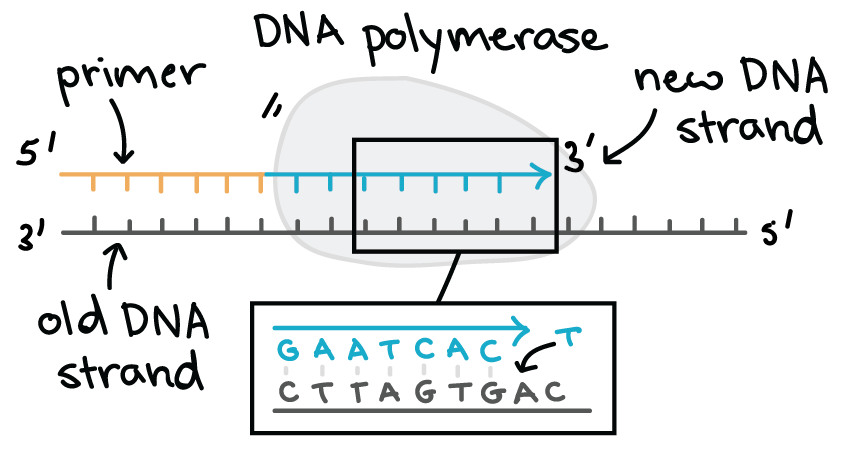
71
New cards
What is the significance of DNA replication on species continuity?
\
The sequence of bases in DNA makes up the genetic code of an individual, the exact copy of this sequence is critical as:
* **Heredity (inheritance of genes)**: genetic material transmitted from cell to cell (mitosis) and from generation to generation (meiosis) must be accurate
* **Gene expression (protein synthesis):** genetic instructions given to a cell to create its structure and ensure its correct functioning must be accurate
By copying genetic material, replication ensures that information important for life is transferred down generations
The sequence of bases in DNA makes up the genetic code of an individual, the exact copy of this sequence is critical as:
* **Heredity (inheritance of genes)**: genetic material transmitted from cell to cell (mitosis) and from generation to generation (meiosis) must be accurate
* **Gene expression (protein synthesis):** genetic instructions given to a cell to create its structure and ensure its correct functioning must be accurate
By copying genetic material, replication ensures that information important for life is transferred down generations
72
New cards
What is the significance of mitosis on species continuity?
* enable genetic material to be copied - enzymes produced by genes ensure that DNA is copied exactly
* allows organisms to grow, maintain and repair body cells
* allows for multicellular bodies
* allows organisms to grow, maintain and repair body cells
* allows for multicellular bodies
73
New cards
What is the significance of meiosis on species continuity?
* increases genetic variation within a species → greater chance of surviving change in environments/natural selection
* enables production of gametes (without organisms can’t reproduce)
* crossing over gives genetic variation
* enables production of gametes (without organisms can’t reproduce)
* crossing over gives genetic variation
74
New cards
What is the difference between prokaryotic and eukaryotic DNA?
* **prokaryotic DNA** is found in the cytoplasm, lacks nucleus and histone proteins and is circular in shape. **SINGLE-CELLED ORGANISMS**
* eukaryotic DNA found in nucleus, bound to histone proteins and is linear in shape. **GENERALLY MULTI-CELLULAR ORGANISMS**
* eukaryotic DNA found in nucleus, bound to histone proteins and is linear in shape. **GENERALLY MULTI-CELLULAR ORGANISMS**
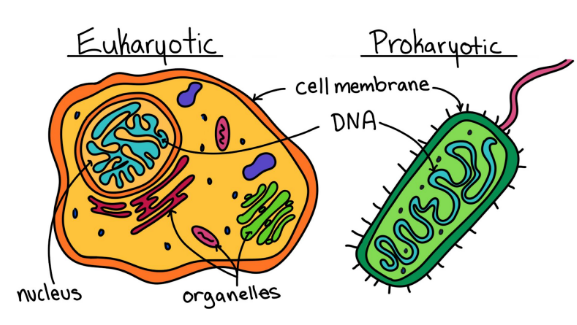
75
New cards
What is a polypeptide?
chain which consists of amino acids
76
New cards
What is RNA?
* single stranded, single nucleobase
* uracil instead of thymine
\
* uracil instead of thymine
\
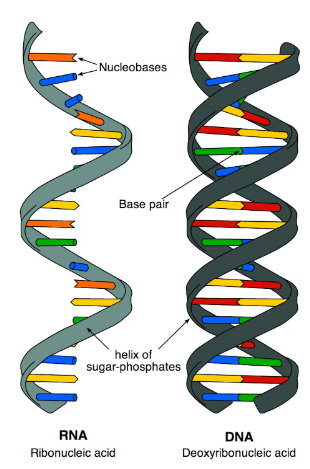
77
New cards
What are the types of RNA?
* **mRNA:** messenger RNA, carries genetic info from DNA to ribosomes
* **tRNA:** transfer RNA, transfers specific amino acids to ribosomes (where they are used to build proteins based on genetic code carried by mRNA)
* **rRNA:** ribosomal RNA, makes up ribosomes along with ribosomal proteins (site for protein synthesis). rRNA helps to catalyse formation of peptide bonds between amino acids during protein synthesis
* **tRNA:** transfer RNA, transfers specific amino acids to ribosomes (where they are used to build proteins based on genetic code carried by mRNA)
* **rRNA:** ribosomal RNA, makes up ribosomes along with ribosomal proteins (site for protein synthesis). rRNA helps to catalyse formation of peptide bonds between amino acids during protein synthesis
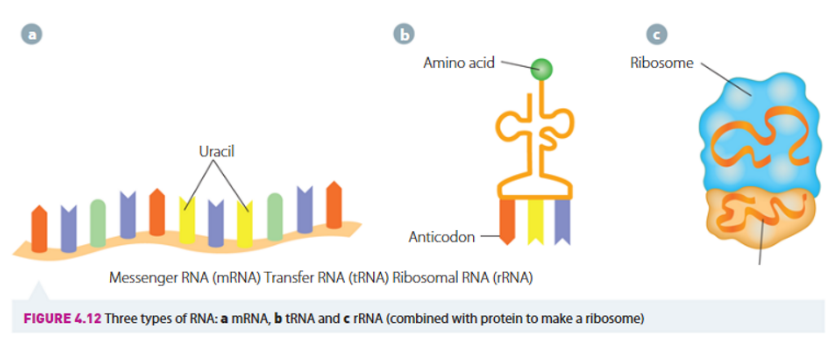
78
New cards
What is a codon table?
* shows the relationships between codons (mRNA) and amino acids
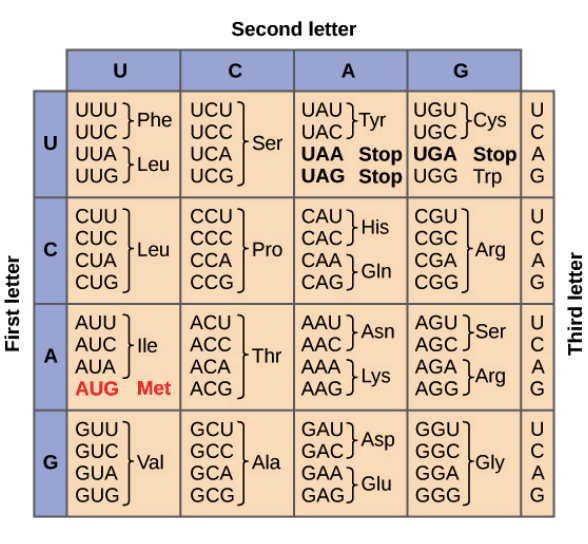
79
New cards
Protein synthesis
* transcription
* translation
* polypeptide
* translation
* polypeptide
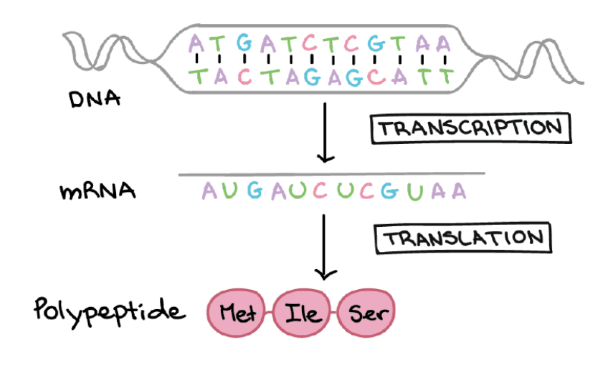
80
New cards
What is the process of transcription?
the process of making an RNA copy of a DNA sequence
* occurs in nucleus (cytoplasm for prokaryotes)
* mRNA copy of a gene is made using DNA as template
process:
1. RNA polymerase attaches to DNA at desired gene & separates strand to expose the nucleotides in that region (replication bubble - only this section is pulled apart)
2. one strand is used as a template to make mRNA strand identical to other strand through complementary base pairings (A-U, G-C)
3. free floating nucleotides pair with their complementary bases on the template strand (non-coding strand), strand not used is non-template or coding strand
* RNA polymerase sticks nucleotides together, adds one RNA nucleotide at a time until whole strand of mRNA is formed
* As this happens, the DNA strands rejoin so the bases aren’t left exposed
4. RNA polymerase reaches a series of bases where hairpin structure will form and transcription is terminated, lets go of the DNA strand → stop codon
5. %%mRNA production complete for prokaryotes%%
6. In eukaryotes, introns (don’t code for proteins) are spliced out of the strand and exons (code for proteins, want to leave) are stuck together to form the final mRNA strand
7. mRNA molecules leave the nucleus and enter the cytoplasm through a nuclear pore
* occurs in nucleus (cytoplasm for prokaryotes)
* mRNA copy of a gene is made using DNA as template
process:
1. RNA polymerase attaches to DNA at desired gene & separates strand to expose the nucleotides in that region (replication bubble - only this section is pulled apart)
2. one strand is used as a template to make mRNA strand identical to other strand through complementary base pairings (A-U, G-C)
3. free floating nucleotides pair with their complementary bases on the template strand (non-coding strand), strand not used is non-template or coding strand
* RNA polymerase sticks nucleotides together, adds one RNA nucleotide at a time until whole strand of mRNA is formed
* As this happens, the DNA strands rejoin so the bases aren’t left exposed
4. RNA polymerase reaches a series of bases where hairpin structure will form and transcription is terminated, lets go of the DNA strand → stop codon
5. %%mRNA production complete for prokaryotes%%
6. In eukaryotes, introns (don’t code for proteins) are spliced out of the strand and exons (code for proteins, want to leave) are stuck together to form the final mRNA strand
7. mRNA molecules leave the nucleus and enter the cytoplasm through a nuclear pore

81
New cards
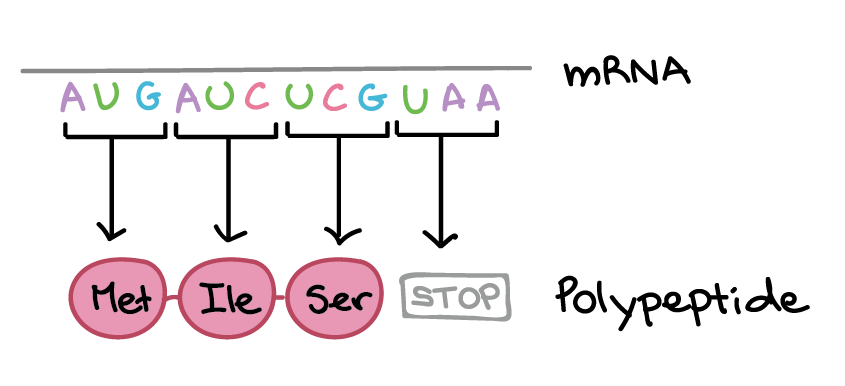
What is the process of translation?
the process of turning information encoded as mRNA into a polypeptide chain
* occurs in cytoplasm at the ribosomes
* involves both tRNA and mRNA
process:
1. mRNA attaches to a ribosome at particular start codon
* free-floating tRNA molecule has specific anticodon (complementary base) sequence that corresponds to a specific mRNA codon
2. tRNA molecule with the correct anticodon pairs up with the mRNA in the ribosome
* specific codon → specific amino acid
3. a second tRNA molecule attaches to the next codon on the mRNA strand
4. ribosome catalyses the formation of a peptide bond between the two amino acids
* first tRNA molecule moves away from the ribosome leaving its amino acid
5. ribosomes continue to move along mRNA until it reaches a stop codon → polypeptide chain has been produced
* Polypeptide remains bound to the ribosome by a single tRNA molecule
6. the polypeptide chain and mRNA strand are released from the ribosome → fold together to make protein
* occurs in cytoplasm at the ribosomes
* involves both tRNA and mRNA
process:
1. mRNA attaches to a ribosome at particular start codon
* free-floating tRNA molecule has specific anticodon (complementary base) sequence that corresponds to a specific mRNA codon
2. tRNA molecule with the correct anticodon pairs up with the mRNA in the ribosome
* specific codon → specific amino acid
3. a second tRNA molecule attaches to the next codon on the mRNA strand
4. ribosome catalyses the formation of a peptide bond between the two amino acids
* first tRNA molecule moves away from the ribosome leaving its amino acid
5. ribosomes continue to move along mRNA until it reaches a stop codon → polypeptide chain has been produced
* Polypeptide remains bound to the ribosome by a single tRNA molecule
6. the polypeptide chain and mRNA strand are released from the ribosome → fold together to make protein
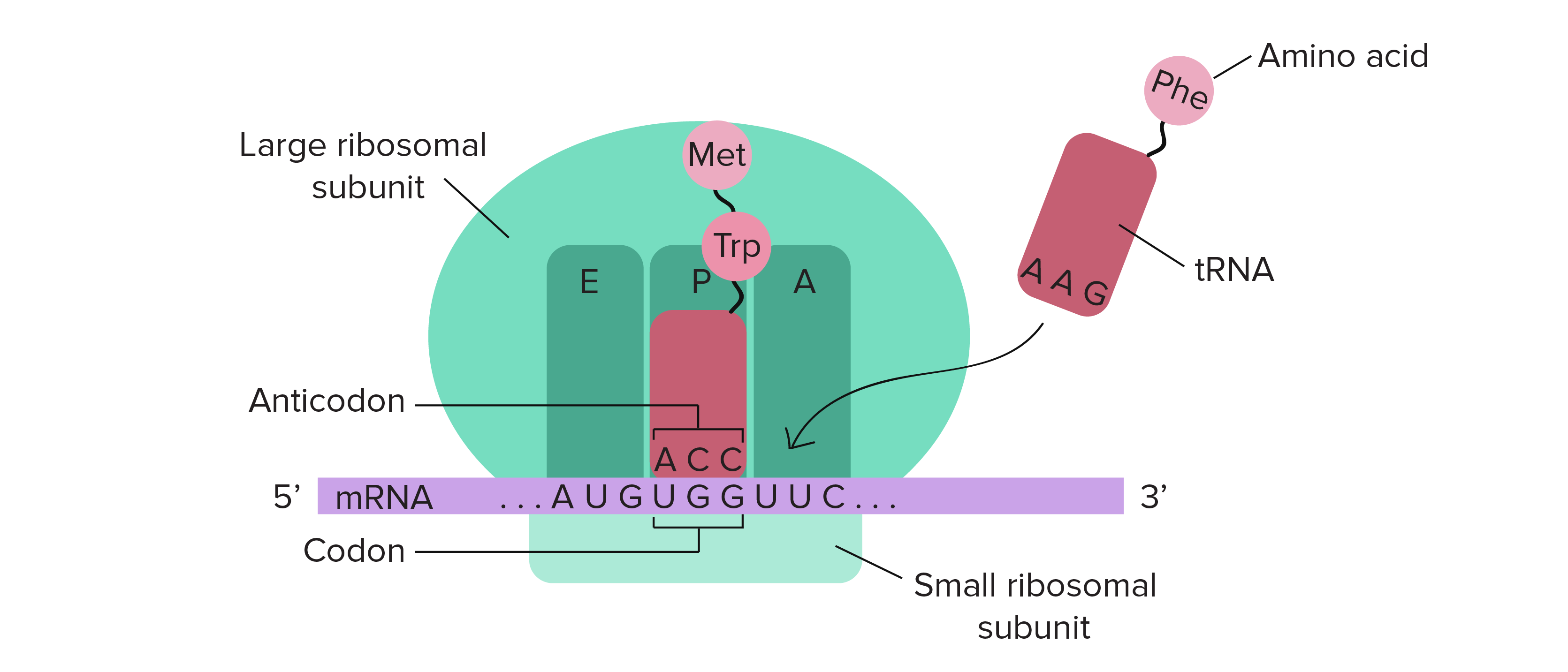
82
New cards
Polypeptide diagram

83
New cards
What is the importance of tRNA in transcription and translation?
\
* without tRNA, the ribosome cannot create proteins.
* tRNA molecules are the carriers of amino acids, which are the backbones of protein molecules
* ensures that its anticodon specifies and binds to the correct amino acid
* without tRNA, the ribosome cannot create proteins.
* tRNA molecules are the carriers of amino acids, which are the backbones of protein molecules
* ensures that its anticodon specifies and binds to the correct amino acid
84
New cards
What is the importance of mRNA in transcription and translation?
* without mRNA, the genetic information in the DNA cannot be translated into proteins, which are essential for the structure and function of cells.
* mRNA carries the information from the nucleus to the ribosome where translation takes place.
* If the mRNA isn’t right, the right polypeptide won’t be created
* mRNA carries the information from the nucleus to the ribosome where translation takes place.
* If the mRNA isn’t right, the right polypeptide won’t be created
85
New cards
What is the function and importance of polypeptide synthesis?
polypeptide synthesis creates proteins, which are essential for the structure and functioning of cells, tissues, and organisms
* inheritance and continuity of a species depends on polypeptide synthesis
* inheritance and continuity of a species depends on polypeptide synthesis
86
New cards
What is a phenotype?
organisms physical expression of a particular characteristic (observable/expressed characteristics of an organism)
87
New cards
What is a genotype?
genetic makeup of an organism, alleles that determine the trait
88
New cards
What is heterozygous?
2 different alleles
89
New cards
What is homozygous?
2 same alleles
90
New cards
How do genes affect phenotype?
* some traits are determined by genes (hair, eye colour etc.)
* dominant traits
* recessive traits
* genes code for phenotype
* dominant traits
* recessive traits
* genes code for phenotype
91
New cards
How does the environment affect phenotype?
* external factors, such as the environment, have a say in how our genes are expressed
* the effect of a gene can be enhanced or masked by variation in the environment
* whilst an organism’s genetic makeup will remain static throughout its life, its observable traits may change over time as a result of the environment
examples:
1. identical twins
* identical twins have identical genotypes
* any phenotypic differences between identical twins must reflect the influence of the environment
* height and weight can be influenced by diet and exercise
2. hydrangeas
* acidity of the soil influences the colour of the flowers
* acidic soil→ develops blue flowers
* alkaline soil → develops pink flowers
* the effect of a gene can be enhanced or masked by variation in the environment
* whilst an organism’s genetic makeup will remain static throughout its life, its observable traits may change over time as a result of the environment
examples:
1. identical twins
* identical twins have identical genotypes
* any phenotypic differences between identical twins must reflect the influence of the environment
* height and weight can be influenced by diet and exercise
2. hydrangeas
* acidity of the soil influences the colour of the flowers
* acidic soil→ develops blue flowers
* alkaline soil → develops pink flowers
92
New cards
What is the importance of proteins?
most abundant organic molecules in cells, responsible for forming the basic structure of cells
\
\
93
New cards
What is the physical structure of proteins?
proteins are made up of one or more polypeptide chains, which consist of amino acids. They can have primary, secondary, tertiary, and quaternary structures
* **primary:** basic structure of a protein, arranged as polymers of amino acids in a linear chain
* **secondary:** three-dimensional arrangement of polypeptide chains created by folding
* hydrogen bonding of the peptide backbone causes the amino acids to fold into a repeating pattern
* **tertiary:** three-dimensional shape of a protein created by attraction between folded polypeptides
* three-dimensional folding pattern of a protein due to side chain interactions
* **quarternary:** three-dimensional structure of a protein made up of two or more polypeptide chains (folded or pleated) that are linked to create a complex but very specific shape
* protein consisting of one or more amino acid chain
* **primary:** basic structure of a protein, arranged as polymers of amino acids in a linear chain
* **secondary:** three-dimensional arrangement of polypeptide chains created by folding
* hydrogen bonding of the peptide backbone causes the amino acids to fold into a repeating pattern
* **tertiary:** three-dimensional shape of a protein created by attraction between folded polypeptides
* three-dimensional folding pattern of a protein due to side chain interactions
* **quarternary:** three-dimensional structure of a protein made up of two or more polypeptide chains (folded or pleated) that are linked to create a complex but very specific shape
* protein consisting of one or more amino acid chain
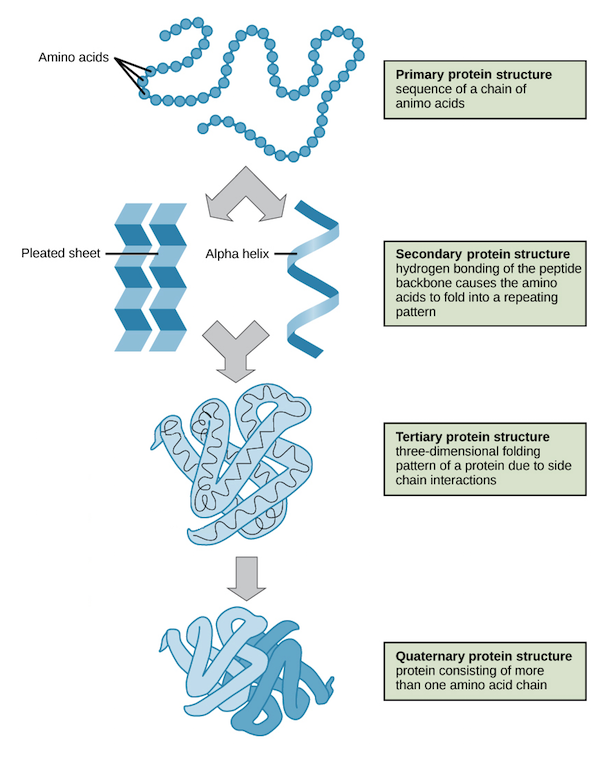
94
New cards
What is the chemical structure of proteins?
contain the chemical elements, carbon, hydrogen, oxygen and nitrogen → combine to form amino acids
95
New cards
What are the two main protein shapes?
* **fibrous:** form structural components of cells and tissues
* long and insoluble in water
* collagen, keratin
* **globular:** often transport proteins
* usually spherical in shape and are compact and soluble in water
* haemoglobin, hormones
* long and insoluble in water
* collagen, keratin
* **globular:** often transport proteins
* usually spherical in shape and are compact and soluble in water
* haemoglobin, hormones
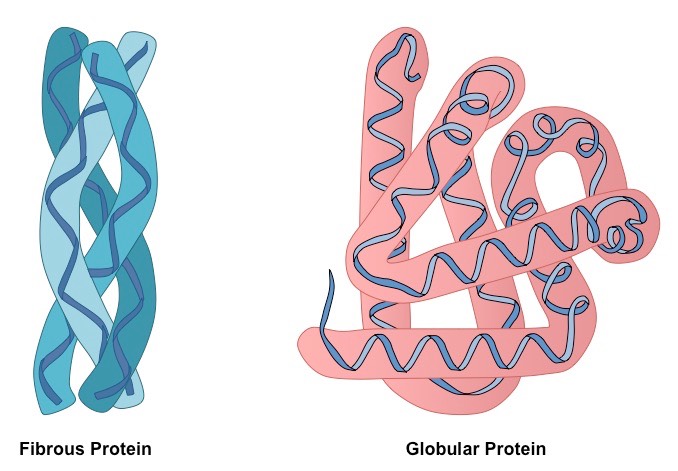
96
New cards
What is the function of proteins?
* structural proteins
* provide support for body and cells
* every cell contains cell membrane, which contains many different structural proteins
* keratin, collagen
* transport proteins
* move molecules around our bodies
* e.g haemogloblin: carries oxygen from lungs to tissues (found in red blood cells)
* enzymes
* catalyse chemical reactions in living cells
* active site of enzyme determines its binding specificity and therefore its ability to function
* lactase
* sensory proteins
* help us detect light, sound, touch, smell, taste, pain and heat
* opsins (eye)
* proteins for cell signaling, communication and biological recognition
* cells communicate by means of chemical signals
* provide support for body and cells
* every cell contains cell membrane, which contains many different structural proteins
* keratin, collagen
* transport proteins
* move molecules around our bodies
* e.g haemogloblin: carries oxygen from lungs to tissues (found in red blood cells)
* enzymes
* catalyse chemical reactions in living cells
* active site of enzyme determines its binding specificity and therefore its ability to function
* lactase
* sensory proteins
* help us detect light, sound, touch, smell, taste, pain and heat
* opsins (eye)
* proteins for cell signaling, communication and biological recognition
* cells communicate by means of chemical signals
97
New cards
What is crossing over of homologous chromosomes?
crossing over occurs during meiosis when homologous chromosomes exchange genetic material, leading to new combinations of alleles
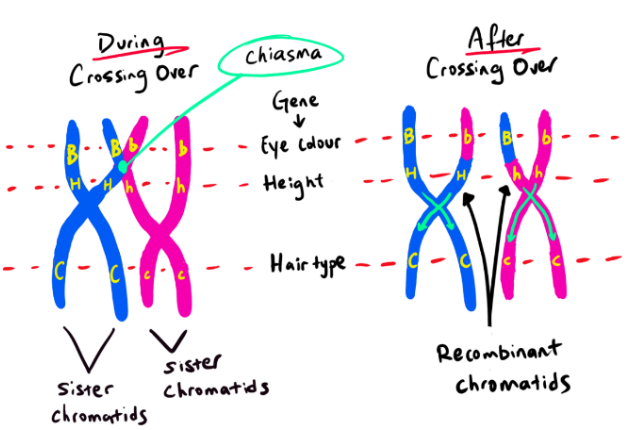
98
New cards
Fertilisation (meiosis)
* each gamete formed from meiosis contains different combinations of alleles for each gene
* during fertilisation, a male gamete (sperm) fuses with a female gamete (egg) to form a zygote → two alleles that form for each gene (e.g. eye colour)
* not only does each gamete contain different, recombined genetic material, but there are many possibilities for which a male and female gamete will fuse
* during fertilisation, a male gamete (sperm) fuses with a female gamete (egg) to form a zygote → two alleles that form for each gene (e.g. eye colour)
* not only does each gamete contain different, recombined genetic material, but there are many possibilities for which a male and female gamete will fuse
99
New cards
What are mutations?
changes in DNA sequence → change the amino acid sequence and polypeptide chain produced at the ribosome
* allow for variation and evolution
* allow for variation and evolution
100
New cards
What are the types of mutation?
Mutation in DNA sequence
* **Point mutation:** substitution of one base for another
* **Frame shift mutation:** insertion or deletion of a base
* **Point mutation:** substitution of one base for another
* **Frame shift mutation:** insertion or deletion of a base
